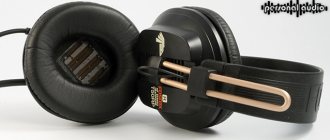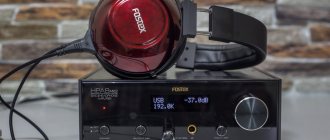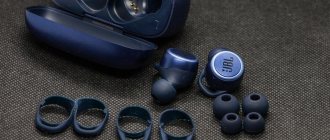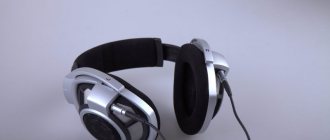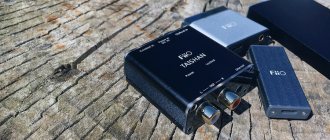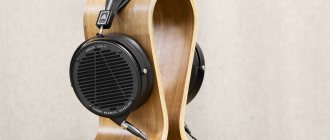Once again we turn to the topic of professional headphones, but this time we will talk about models that are well known to experienced audiophiles. The very name Fostex already says a lot, and after reading the names of the models, seasoned users of personal audio will probably close this page - they will think that they will not learn anything new from this article, because today two super-popular planar-magnetic models descended on my head and on the measuring stand: T40RP and T50RP. Why are they so loved and is it worth running to the store right now if you don’t have such headphones yet? This question has been bothering me for a long time, so I had to call two models at once for a confrontation, both in the latest incarnation MK3.
On flat magnets
The history of the models in question goes back more than 30 years - that’s how long ago the first T-series model was released. Its key feature was the planar-magnetic or, in that case, orthodynamic design. Modern versions are equipped with square-shaped isodynamic emitters made using Regular Phase technology. Powerful neodymium magnets and a polyamide cone with copper conductive tracks provide not only sound quality, but also solid overload capacity. The headphones can be connected to an amplifier with an output power of up to 3 W!
While the appearance of previous versions of headphones is similar to the new MK3 models, the latter have a number of improvements, the details of which are described very vaguely. We are talking about changing the design of the headband, housings and ear pads, and the main goal of the improvements is obviously user comfort. How all this affected the sound and whether it had an effect in principle is difficult to say.
Prerequisites for modding Fostex T50RP
Here's what SGS writes on its blog: “... in my opinion, their driver design is flawed, despite the fact that the membrane is of very high quality, albeit small. Here they mentioned the influence of the mesh on the sound, but what do we have with this driver? Fostex saved on magnets, instead of five he put 3, and the role of the rest is played by a metal plate between them in which 42 holes of 2 mm in diameter were made for the passage of sound with a total equivalent area of 132 mm2. This corresponds to a hole with a diameter of about 13mm or approximately 15% of the membrane area. In addition, the holes are so small that they are equal to or less than the wavelength of the emitted sound. From the school physics course I vaguely remember that in this case the wave is emitted as if from a point with a circular front. I think this is called diffraction. Then the waves add up again with different phases at different points in space and this phenomenon is called interference. I'm not even saying that the sound is locked between two bare metals. plates and is reflected from them many times before breaking out. Why then be surprised at the cottony, muddy sound of the Fostexes and that their sound is so different from other isodynamics.”
Comments from the author of the mod in question:
So, I completely removed all the partitions between the magnets on the outer half of the driver, freeing up space for sound as much as possible. Firm, controlled damping was applied to the inner half of the driver by sealing the “extra” holes with natural suede.
There is additional felt damping on the outside of the driver with an adjustable hole to tailor the tonal balance to the specific path and listener preference. In addition, the thickness of the additional gasket between the phone body and the ear pads was selected.
Among other things, the cable was also replaced with a CANARE L-2T2S (with the “correct” wiring directly to the drivers). Now the eternal bug with channel imbalance from an oxidized connector on the earcup is a thing of the past.
Reworking the magnetic system must first of all affect the sensitivity of the headphones due to a decrease in the magnetic flux, and objective measurements clearly confirm this.
The main change in the frequency response is expressed in a decrease in output in the mid-frequency region to 12 dB.
The overall sound of the headphones is radically different from the stock ones - a completely different frequency balance. If the stock ones stand out in the middle and moderate lows and highs, then the modified ones have deep bass and brighter highs. From the standpoint of professional use, modified headphones color the sound too much, but from the standpoint of an audiophile who needs a pleasant and interesting sound, this is what they need. Together with the new tonal balance, the cohesion and naturalness of the scene, characteristic of headphones with a flat driver, is completely preserved, when the scene is perceived naturally and naturally.
Modified headphones are more demanding of amplification and require a more powerful amplifier due to reduced sensitivity.
After getting acquainted with the mod, it’s a pity that instead of releasing a similar version by Fostex themselves, they instead released modifications of the famous headphones from Denon in the form of TH 600 and TH 900 without the use of isodynamic drivers.
Not for beauty
The headphones have a very brutal design, and, in my opinion, there is nothing homely about them at all. They look purely professional, which in essence they are. More precisely, they appeared until audiophiles fell in love with them. After all, as you know, in addition to dubious aesthetic value, professional models have practical values. In this case, we are talking about a powerful design with cup fastenings made of 5 mm steel wire and solid screws that tighten the edges of the headband. Looks completely indestructible.
The specificity of professional headphones is a powerful and very practical design
The headband itself is flexible and at the same time holds its shape well, giving a noticeable pressing force. The landing did not seem comfortable to me from the very beginning. It happens that you literally can’t feel the headphones on your head, and although these ones feel light in weight, they still put pressure on top of the headband and press the ears to your head. For me, these headphones became not full-size, but on-ear, with all the ensuing consequences in the form of a feeling of completely “trampled” ears after an hour of wearing. Although those with small ears will not agree with me, because their ears will fit inside the ear pads, and these same headphones will become full-size for them. In photos on the Internet, I came across the same headphones with ear pads of a different shape, deeper and with more free internal space. These would have suited me perfectly, but it was some kind of non-serial modification.
The ear pads have shallow depth and very tight interior space
I was pleasantly pleased with the quality of the standard ear pad materials. Perhaps this is exactly the same modification of “MK3”. The soft artificial leather covering the ear pads and headband is pleasant to the touch. It does not have breathable properties and retains heat well, so after an hour or two you can expect a greenhouse effect, but I was not able to wait for this effect.
Bottom line
Fostex T40RP MK3 are excellent closed full-size isodynamic headphones . For studio and home. Excellent sound and very reliable design. With good amplification, this model will perform at the level of much more expensive competitors. One of the best combinations of price and quality. Especially if you are not chasing audiophile “perfect sound”.
- Fostex T40RP MK3 on the manufacturer’s website: https://fostexsound.ru/
Pros:
- High quality sound .
Natural, precise, fast and bright. And at the same time with good and powerful bass. A great idea for beginning audiophiles. In principle, you can end your search for decent sound with these headphones.
